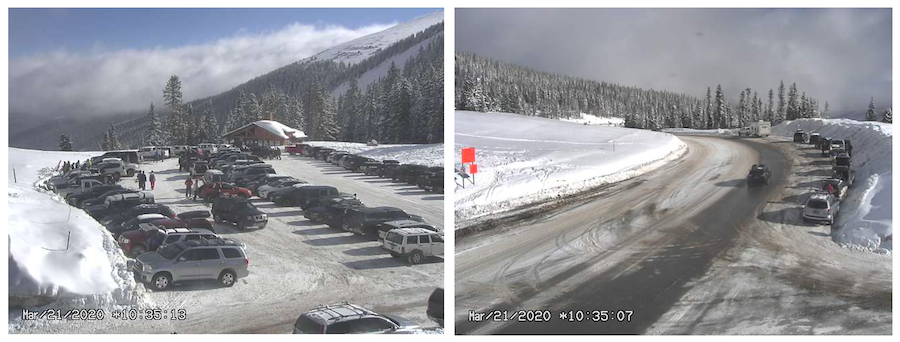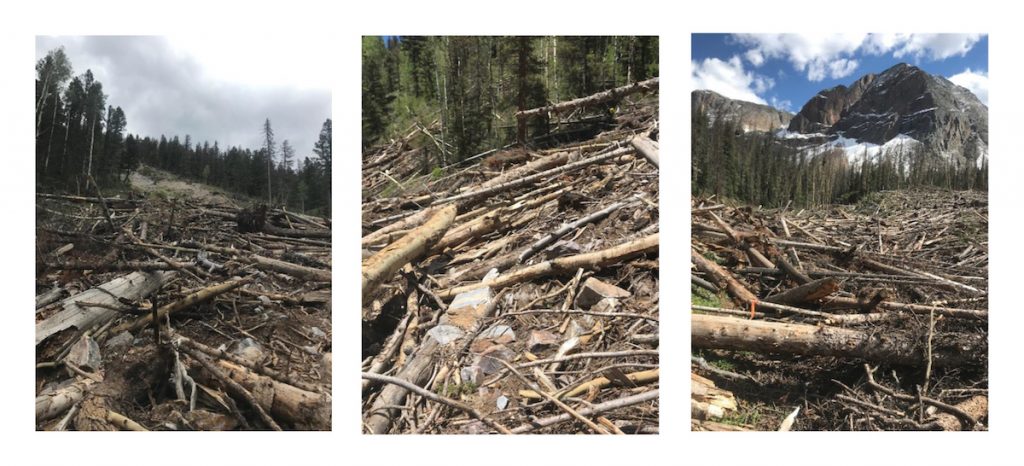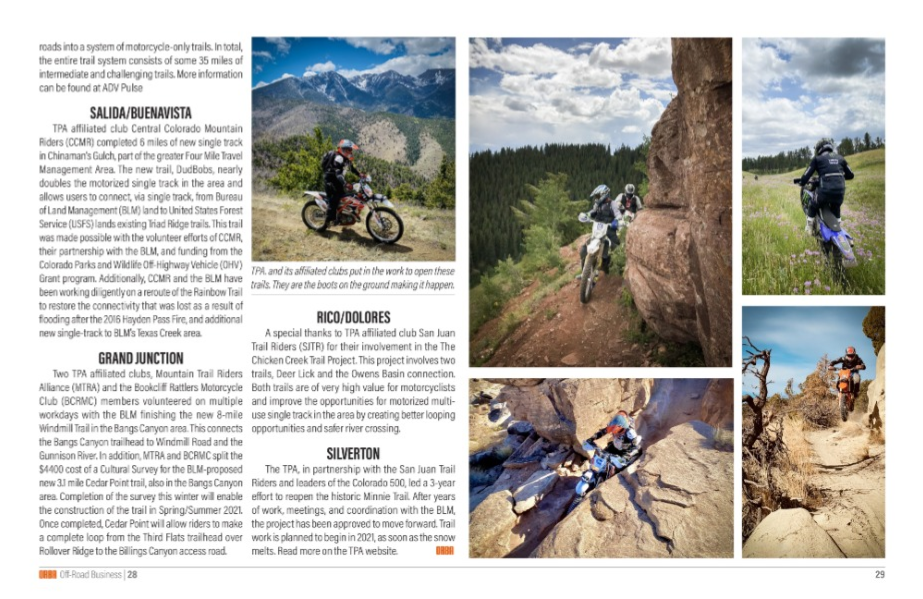GMUG National Forest
Att: Chad Stewart, Forest Supervisor
2250 South Main Street
Delta, CO 81416
Re: GMUG Resource Management Plan Revision
Dear Chad:
Please accept this correspondence as a continuation of the on-going conversation that the GMUG started with the public with the pre-NEPA release of a draft of the proposed RMP in 2019. The Organizations continue to vigorously support this ongoing less formal communication process with the Forest when compared to the NEPA process. The flexibility of this process will prove invaluable in the RMP development given the ongoing challenges that resulted from 2020 and the ever-evolving wildlife challenges. The Organizations believe the success of this flexibility in planning development should be carried through into the RMP development to allow the forest to quickly adapt to changes no one could possibly foresee at the time the RMP was developed. With this correspondence we are highlighting the benefits of flexible management from 2020 experiences and the need to continue and expand management flexibility that were identified throughout the region moving forward.
The Organizations have been active participants in many discussions and rulemaking efforts by the USFS where increased flexibility in the planning process has been the goal. These would include successful development of the new USFS planning rule, revision of the Colorado Roadless Rule and revision of USFS NEPA regulations. All these efforts have provided more management flexibility for the land manager to address issues. These efforts only are effective if flexibility in the RMP is provided as well. 2020 has provided even more compelling examples of why this type of flexibility is necessary. We hope to identify a few of these examples in this letter as many of the issues faced did not directly impact the GMUG but rather occurred on lands adjacent to the GMUG.
Lessons from the 2020 Wildfires in the Region
Wildfire impacts continue to be a huge long-term concern for the recreational community, as any trail that is impacted by wildfire can be closed for decades and possibly permanently. Wildfire impacts extend well beyond the trails community to all people in the vicinity of these burn scars as exemplified by the 3 Colorado residents that were recently killed inn flash flooding in the Poudre Canyon that resulted from the Cameron Peak Fire. We hope everyone can agree these deaths are unacceptable and all efforts should be made to avoid these types of situations moving forward. 2020 proved to be an exceptionally challenging year for wildfires in the Colorado region, and unfortunately the Organizations believe this is a harbinger of fire seasons that will be experienced over the life of the RMP. Often these fires have been summarized as aggressive and devastating due to fuel loads and often the public has thought there was nothing that could be done to mitigate or reduce the impacts of fires of this size and intensity. Review of these fires that has recently occurred indicate that the public perceptions on these large fires may be unnecessarily grim and management can be effective.
The scale of the challenges being faced are exemplified by the East Troublesome Fire on the Sulphur Ranger District, the Mullen Fire on the Laramie Ranger District and Cameron Peak Fire on the Canyon Lakes Ranger District or the Grizzly Creek Fire on the White River. Glenwood Springs was forced to rely on portable filtering equipment after all their existing resources were compromised by the Grizzly Creek Fire; the Mullen and Cameron Peak fires impacted the Cities of Laramie and Cheyenne, Wyoming; Fort Collins, Loveland and Greeley, Colorado in a similar manner after most of the watersheds around municipal reservoirs were heavily impacted by these fires. The Grizzly Creek Fire has reduced I70 through Glenwood Canyon to almost a limited use highway due to the ongoing mud and debris slides from the burn scar. These are simply issues and challenges that no one would have predicted in 2019.
While there were significant impacts to all forms of infrastructure, ranging from water resources to interstate highways to local economies, these fires have also provided a significant learning opportunity for managers. We recently participated in round table discussions as part of the CPW Partners in the Outdoors event with numerous Forest Supervisors on the lessons from these fires in terms of behavior of the fire and how to effectively manage these highly intense fires moving forward. Here is a link to that discussion: PiTO Session NFF USFS Managing Wildlife_Recording.mp4 – Google Drive
This discussion started with a highly detailed day by day analysis of the behavior of several fires in the 2020 season. While everyone is aware of the fact that often issues such as this are often highly related to local factors such as topography, weather and fuel loads, there were several characteristics that consistently were present in these fires, such as the fires naturally igniting in areas were high levels of management restrictions were present and slowly developing in these heavily restricted areas. These fires then explosively grew into areas where large amounts of development or other values were present and created significant impacts to a wide range of uses. At this point, firefighters were not able to control this expansion, which immediately lengthened impacts to almost every resource present in these areas resulted.
In 2020, this trend of fire behavior was exemplified by the Mullen Fire igniting in the Savage Run area; the Cameron Peak fire igniting in the Rawah area and then impacting the Commanche Peak are and the Troublesome Fire burning in and around the Vasquez Peak area and heavily impacting Rocky Mountain National Park. Unfortunately, this characteristic has become common in Colorado as exemplified by the 2013 West Fork Complex Fire ignition in the Weminuche area and the 2018 416/Burro Fire involving several designated remote areas. With several fires again following this model this year, exemplified by the fires simmering in the Mt. Zirkel and Mt. Sarvis areas outside Steamboat this appears to be a new normal for fires in Colorado. We have no reason to expect this fire behavior to change over the life of the GMUG RMP.
While the presentation from the CPW “Partners in the Outdoors” event is somewhat lengthy and at times troubling to those that may have been impacted by fire due the analysis of fire behavior, it provided a far more optimistic view of the ability to mitigate impacts and manage even large-scale events such as with tools such as timber harvests and controlled burns at a scale we have never imagined before. While we are aware there are many factors that might be outside a manager’s ability to alter, such as difficult topography in fire impacted areas, prescribed fire and timber harvests are tools that can only be used when there are high levels of management flexibility in the areas to be addressed.
Unforeseen impacts of the large-scale high intensity types of fires continue to be identified, and the lack of ability to foresee possible issues creates a need for more flexibility in management. In February 2021 presentations to the public, the Rio Grande NF in partnership with Colorado Parks and Wildlife provided detailed analysis of post fire impacts from the West Fork Complex Fire to federally protected Lynx on the forest.[1] This cutting-edge research showed that while many species returned to low intensity burn scars rather quickly, Canadian Lynx showed a strong aversion to using these areas for a long time. While we are unsure what this means long term, management flexibility to address these types of unforeseen challenges is probably wise.
Unfortunately, the need for management flexibility to address fires is not a new discussion but rather one that has been around for an extended period of time. This is exemplified by the 2011 Rocky Mountain Research Report prepared at the request of Senator Mark Udall entitled “A Review of the Forest Service Response: The Bark Beetle Outbreak in Northern Colorado and Southern Wyoming.” [2] In this report, the Research Station clearly identified the challenges to forest health that result from management restrictions and actually predicted the expanded impacts of wildfire if management was not undertaken. Despite this highly credible analysis of fires and beetles, many still oppose any management on this issue seeking to protect resources by restricting public access to them and managers ability to manage them.
Why this warning would not remain valid as a management concern is unclear to us but continues to occur as the Organizations were recently asked to support proposed legislation that would only provide funding for treatments and management on areas that were not Wilderness or Roadless in nature.[3] Effectively, this Legislative Proposal precluded treatment on more than 50% of USFS lands in the region and as a result was not supported by us. We instead chose to support proposals that reduced management barriers for treatments and added funding. [4] This is simply another example to us of the ongoing need to speak up for active management of forests and continue to support management flexibility in planning and we are doing so in this letter. Forest health is a major concern for any forest plan being developed and management flexibility is a major component of addressing this challenge. The Organizations submit these lessons must be quickly applied in any RMP being developed and not be allowed to be simply overlooked as has happened to so many other documents. There are learning experiences that have come out of 2020 and we should be learning from these events.
Lessons from 2020 Recreational Visitation Spikes
2020 also provided managers unique opportunities to gain insight into management challenges that could result over the life of an RMP regarding recreational access. This opportunity results from the fact that most public lands saw an increase in visitation of about 30% on average and some areas saw increases of 200-400% of average visitation. The overwhelming portion of this usage was focused on the less restricted areas of the forest in general, which is significant as almost 50% of the GMUG is restricted either by Congressional designation or via a similar agency restriction such as a Colorado Roadless or Colorado Upper Tier Roadless type designation.
Again, these experiences highlighted the need for management flexibility in addressing concerns around existing facilities and also the need to expand recreational access on the forest to account for this level of increased visitation. We believe the amount of increase in visitation is significant as clearly over the life of the RMP, recreational visitation across the GMUG could easily exceed the 30% average that was experienced in 2020. Much of the 50% of the GMUG that is currently restricted for usage is not able to provide flexibility to adapt to these new demands and visitors making us question why there would be any desire to expand restrictions.
An example of the clear need to expand facilities across the state was provided by the rapid closure of the State in response to the COVID outbreak. In March of 2020, Governor Polis closed ski areas due to the COVID outbreak when these resorts were near capacity. This immediately pushed visitation levels to many dispersed areas throughout the region far beyond their carrying capacity. The following pictures represent the conditions at parking areas on Berthoud Pass in Grand County.

While these issues are not on the GMUG, we submit that they were symptomatic of conditions throughout the region at the time and an example of what was seen in the less restricted 50% of the GMUG lands. This is also a good example of what existing facilities will look like with significantly increased visitation, and possibly may look like towards the end of the GMUG new RMP life. We don’t believe this picture is acceptable to anyone. There is really only one answer to this type of challenge. Opportunities need to be expanded at existing sites and new sites need to be created and this type of management direction can only occur when there is flexibility in planning. Without this type of management flexibility, these types of experiences will become common place towards the end of the new RMP life. This is not acceptable to us.
The challenges that have been faced in 2020 from the increased visitation were not limited to roadside facilities along major interstates but rather were experienced throughout the range of the management spectrum. Consistently users sought out their own experiences when existing facilities were either overwhelmed or totally unavailable for use and we don’t see that situation changing regardless of the timeframe being reviewed. This desire to find an experience brought increased pressures to areas facing significant challenges due to unavoidable conditions such as landslides, blow downs or simple lack of funding. This change was exacerbated by high levels of restrictions on how these challenges may be managed and are commonly experienced in the 50 % of the GMUG subject to heightened management restrictions. The inability to respond to these types of challenges in a timely manner is exemplified by maintenance efforts around the Elk Creek portion of the Continental Divide Trail in Columbine Ranger District in the Weminuche Wilderness. This portion of the trail is only 1/3 of a mile in length. Below is a picture of one of three piles of debris on the Trail after literally weeks of hand work by the Conservation Corp. to open the trail.

Obviously, this is a HUGE amount of effort to open the trail even this far but there is really no argument that providing these kinds of basic services is complicated hugely by the large number of restrictions on this area. Simply deploying resources to the area is difficult as mechanical transportation is not allowed. The scale of these efforts is made even more daunting by the fact there are multiple other larger piles that must be removed as well. The photos below represent those piles.

Operating under the current restrictions with existing resources, this challenge could literally take years to repair even though it is only 1/3 of a mile in length. The USFS has sought to address these types of challenges more effectively and efficiently as evidenced by proposals on the Rio Grande NF to reopen trails and access in highly restricted areas by utilizing authority to use mechanical equipment in these areas provided under the Colorado Wilderness Act.[5] This proposal was immediately legally challenged and withdrawn.
The USFS has sought to work more efficiently and has proposed the large-scale use of explosives to blow these barriers up and reopen the trail, which the Organizations simply must commend as a super creative resolution to the challenge. We are also aware of the use of explosives previously in other portions of the trail and around water resources in heavily managed areas. While this resolution is commendable, it is certainly not efficient and this lack of efficiency has been recognized by the USFS previously as it is a challenge not only to fixing the condition on the trail or reservoir but simply safely deploying resources to these areas can be difficult. [6] The Organizations also must believe that while explosives on a very limited site-specific basis may be socially sustainable, the Organizations also believe that there would be significant public opposition and concern if the USFS frequently started using explosives as a management tool on the landscape. The Organizations submit there is a limited scope of users seeking the recreational experience provided in these more restricted areas and the recreational experience is often degraded as a result of these management restrictions. Maintenance on opportunities in the more restricted 50% of the GMUG rapidly becomes expensive and as a result degrades the quality of the recreational experience provided to the users.
Compare the challenges and litigation the USFS is facing trying to maintain access and healthy ecosystems in heavily restricted areas to the successful management efforts that have occurred in areas where there are higher levels of management flexibility allowed. An example of how effective management can be when it is not burdened by high levels of restrictions is provided by restoration efforts in areas impacted by the East Troublesome Fire on the Sulphur Ranger District, where partial access was rapidly reopened the need for management flexibility is immediately clear. Literally hundreds of miles of roads and trails in areas with limited management restrictions, sometimes buried in feet of snow, were rapidly assessed and cleared. After this assessment and stabilization effort safe public access for recreational activity was rapidly restored.[7] While the Organizations are aware that every site and project provides unique challenges, the Organizations submit this type of massive project would still be ongoing in Grand Lake if management restrictions were in place at levels found in some areas. Simply covering the hundreds of miles of trails on foot and removing hazards by hand would have taken possibly years.
The Organizations submit that the social benefits of lower levels of management restrictions cannot be overlooked either. The Organizations would also note that the Grand Lake efforts were hugely successful in uniting a wide range of people and interests in the project, while similar efforts in more restrictive areas drew litigation. Building communities around successful projects only creates more success in the future as land managers are facing new and unique challenges. Obviously, this is a win for everyone compared to the immediate litigation that resulted from efforts to effectively manage areas subject to higher levels of restrictions. Again we must ask why increases for restrictions would be sought in the face of the social opposition that is so common in the public when they can’t fix problems.
Conclusion
The Organizations continue to welcome the benefits of the current conversational nature of efforts with the GMUG as we believe this flexibility will create a better forest plan. The Organizations believe this flexibility is superior for information gathering when compared to the formal structure of the NEPA process. The Organizations believe that there are many things that can be learned from everyone’s experiences in 2020 including examples of how flexibility in management has allowed the effective recovery from a wide range of challenges that were presented. We hope this correspondence identifies new information on these issues to clarify public support for effective management of public lands that has been identified and worked towards in many ways over the last several years. Effective management benefits all users and protects all resources from a growing array of unprecedented challenges and this must not be overlooked as 50% of the GMUG is already subject to some heightened level of management restriction. We must ask why increasing this type of restriction would make any sense in the face of such a compelling need for more flexibility in management that has been provided by our 2020 experiences on the GMUG and throughout the region.
The Organizations would welcome a discussion of these opportunities and any other challenges that might be facing the GMUG moving forward at your convenience. Please feel free to contact Don Riggle at 725 Palomar Lane, Colorado Springs, 80906, Cell (719) 338- 4106 or Scott Jones, Esq. at 508 Ashford Drive, Longmont, CO 80504. His phone is (518)281-5810 and his email is scott.jones46@yahoo.com.
Respectfully Submitted,
Scott Jones, Esq.
COHVCO & CSA Authorized Rep
Don Riggle
Director of Operations
Trails Preservation Alliance
[1] See, Canada lynx navigate spruce beetle-impacted forests | Rocky Mountain Research Station (usda.gov)
[2] A complete copy of the 2011 Forest Health report prepared at the request of Senator Udall is available here: HMTG-116-II10-20190710-SD006.pdf (house.gov)
[3] A complete copy of this proposal is available here: Bennet Introduces Legislation to Invest in Forest, Watershed Restoration Across the West | Press Releases | U.S. Senator Michael Bennet (senate.gov)
[4] A copy of this proposal is available here: untitled (house.gov)
[5] See, PL 96-560 §109
[6] See, Forest crew uses explosives in wilderness area | Wyoming News | trib.com
[7] See, Fire damage won’t stop snowmobiling in Grand Lake | SkyHiNews.com






